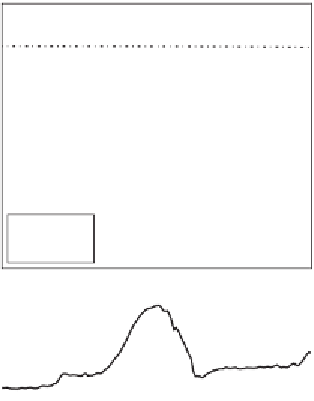Geoscience Reference
In-Depth Information
5
0
-5
-10
-15
z
= 10 cm
surface
z
d
= 5 cm
-20
50
Q*
G
0
-50
-100
036912
15
18
21
24
Time (hour UTC)
Figure 2.29
Temperatures above and below a snow pack on grass on the Haarweg
meteostation, January 6, 2009 (upper panel): air temperature 10 cm above ground
level, surface temperature (from emitted longwave radiation, assuming an emissiv-
ity of 0.95) and soil temperature at 5 cm below ground level. The snow layer had a
thickness of approximately 2 cm and started on January 5. Lower panel shows the
net radiation and the soil heat lux at the surface (approximated by the soil heat lux
at 2 cm depth, below bare soil).
layer will usually be due to melt. The meltwater subsequently can be removed by iniltra-
tion into the soil, surface runoff (in case of saturated or frozen soil) or evaporation.
If the snow cover is continuous the process of snow melt may be slow, because,
owing to the high albedo of snow, the net radiation will be low. However, as soon as
at some places the (darker) underlying soil, stones or vegetation protrude through the
snow, the net radiation will - locally - increase, the supply of heat to the melting pro-
cess will increase and the decrease of the snow cover will accelerate.
Question 2.25:
Given that the latent heat of fusion of water is approximately 0.33 10
6
J kg
-1
.
a) How much energy is needed to melt completely a layer of old snow of 10 cm thick-
ness (check
Table 2.2
for the density of snow)?
b) If the daily mean net energy input into the snow layer (net radiation, supply from the
soil, and ignoring the sensible and latent heat lux) is 40 W m
-2
, then how many days
will it take before the snow has completely melted?
Question 2.26:
Given the observations in
Figure 2.29
.
a) Estimate (using Eq. (
2.46
)) the temperature difference over the snow layer at night
around 21 UTC, assuming the snow layer is 2 cm thick. Given the fact that the snow
is only one day old, you can assume that this is fresh snow. Is your answer consistent
with the data shown in the igure?








































































Search WWH ::

Custom Search